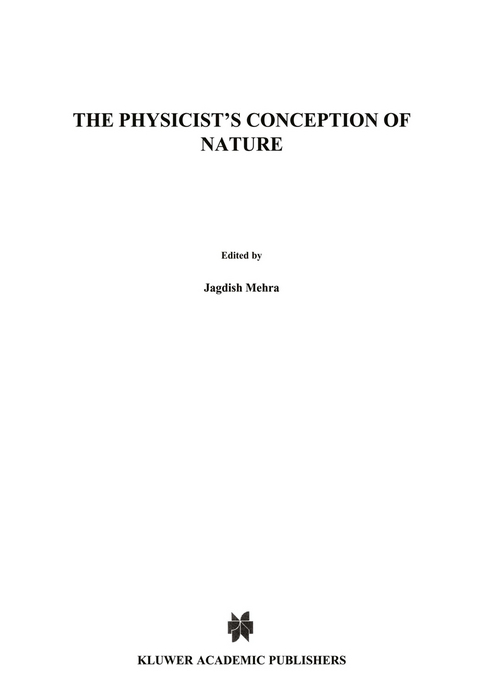
The Physicist's Conception of Nature
Springer (Verlag)
978-94-010-2604-8 (ISBN)
The fundamental conceptions of twentieth-century physics have profoundly influenced almost every field of modern thought and activity. Quantum Theory, Relativity, and the modern ideas on the Structure of Matter have contributed to a deeper understand ing of Nature, and they will probably rank in history among the greatest intellectual achievements of all time. The purpose of our symposium was to review, in historical perspective, the current horizons of the major conceptual structures of the physics of this century. Professors Abdus Salam and Hendrik Casimir, in their remarks at the opening of the symposium, have referred to its origin and planning. Our original plan was to hold a two-week symposium on the different aspects of five principal themes: 1. Space, Time and Geometry (including the structure of the universe and the theory of gravita tion),2. Quantum Theory (including the development of quantum mechanics and quantum field theory), 3. Statistical Description of Nature (including the discussion of equilibrium and non-equilibrium phenomena, and the application of these ideas to the evolution of biological structure), 4. The Structure of Matter (including the discus sion, in a unified perspective, of atoms, molecules, nuclei, elementary particles, and the physics of condensed matter), and finally, 5. Physical Description and Epistemo logy (including the distinction between classical and quantum descriptions, and the epistemological and philosophical problems raised by them).
1 Development of the physicist’s conception of nature.- I Space, Time, and Geometry.- 2 The universe as a whole.- 3 A chapter in the astrophysicist’s view of the universe.- 4 Fundamental constants and their development in time.- 5 The expanding earth.- 6 The nature and structure of spacetime.- 7 Einstein, Hilbert, and the theory of gravitation.- 8 Theory of gravitation.- 9 From relativity to mutability.- II Quantum Theory.- 10 The wave-particle dilemma.- 11 Development of concepts in the history of quantum theory.- 12 From matrix mechanics and wave mechanics to unified quantum mechanics.- 13 Early years of quantum mechanics: some reminiscences.- 14 The mathematical structure of elementary quantum mechanics.- 15 Relativistic equations in quantum mechanics.- 16 The electron: development of the first elementary particle theory.- 17 The development of quantum field theory.- 18 Quantum theory of fields (until 1947).- 19 Development of quantum electrodynamics.- 20 A report on quantum electrodynamics.- 21 Progress in renormalization theory since 1949.- 22 Some concepts in current elementary particle physics.- 23 Crucial experiments on discrete symmetries.- 24 Superconductivity and superfluidity.- III Statistical Description of Nature.- 25 Problems of statistical physics.- 26 Phase transitions.- 27 Approach to thermodynamic equilibrium (and other stationary states).- 28 Kinetic approach to non-equilibrium phenomena.- 29 Time, irreversibility and structure.- 30 The origin of biological information.- IV Physical Description, Epistemology, and Philosophy.- 31 Classical and quantum descriptions.- 32 Wavefunction and observer in the quantum theory.- 33 The problem of measurement in quantum mechanics.- 34 Subject and object.- 35 Subject, object, and measurement.- 36 Measurementprocess and the macroscopic level of quantum mechanics.- 37 Why a new approach to found quantum theory?.- 38 A process conception of nature.- 39 Quantum logic and non-separability.- 40 Physics and philosophy.- V Memorial Lectures.- 41 Recollections of Lord Rutherford.- 42 W. Pauli’s scientific work.- 43 Remarks on Enrico Fermi.- VI Celebration of P.A.M. Dirac’s 70th Birthday.- 44 The banquet of the symposium — in honour of Paul Dirac, including an address on: The classical mind.- Appendix 1 Programme of the symposium.- Appendix 2 Participants.- Index of names.
| Zusatzinfo | XXIV, 839 p. |
|---|---|
| Verlagsort | Dordrecht |
| Sprache | englisch |
| Maße | 178 x 254 mm |
| Themenwelt | Naturwissenschaften ► Physik / Astronomie ► Allgemeines / Lexika |
| ISBN-10 | 94-010-2604-1 / 9401026041 |
| ISBN-13 | 978-94-010-2604-8 / 9789401026048 |
| Zustand | Neuware |
| Haben Sie eine Frage zum Produkt? |
aus dem Bereich


